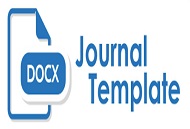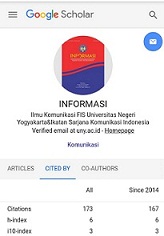Literasi Media Sosial Humas Pemerintah Daerah
DOI:
https://doi.org/10.21831/informasi.v47i2.17235Keywords:
New Media, Social Media Literacy, Local Government Public RelationAbstract
Nowadays, the government is trying to fight against hoax. One of them, President
Joko Widodo instructed to improve the function of government public relations and
information managers to ward off hoaxes spread quickly in social media. However, it
will work if government public relations officers have adequate social media literacy
skills. Social media literacy is considered the basis for understanding the characteristics
of new media. The aim of this research is to examine the level of social meda literacy
among local government public relations at present. Quantitative approach with survey
method will be used in this research. The study was conducted in eight local governments
that have held anti-hoax declarations. The eight local governments are: Semarang
regency, Semarang city, Wonosobo regency, Solo city, Banyumas regency, Blora
regency, Yogyakarta city and Province of Bali. Based on the research analysis, it can be
concluded that the managers of social media public relations of local governments who
have held anti-hoax declaration are already have enough social media literacy. The local
government needs to increase knowledge and skills that are technical about new media
and social media in order to optimize the function and the role of local government
public relations in the effort to ward off hoaxes. While the hardest part of social media
literacy, which always involves the criticality literacy media, most of local government
public relations have already master it.
Pemeritah saat ini berusaha melawan berita-berita hoax. Salah satunya, Presiden Joko Widodo menginstruksikan untuk meningkatkan fungsi humas pemerintah dan pengelola informasi untuk menangkal hoax yang tersebar cepat di media sosial. Namun, hal itu akan berhasil jika para petugas humas pemerintah mempunyai kecakapan literasi media sosial yang memadai. Literasi media sosial dianggap sebagai dasar memahami karakteristik media baru. Penelitian ini akan melihat sejauh mana tingkat literasi media sosial di kalangan humas pemerintah daerah saat ini. Penelitian menggunakan pendekatan kuantitatif dengan metode survei. Penelitian dilakukan di delapan pemerintah daerah yang telah menggelar deklarasi anti hoax, yakni Kota Semarang, Kabupaten Semarang, Kabupaten Wonosobo, Kota Solo, Kabupaten Banyumas, Kabupaten Blora, Kota Yogyakarta, dan Provinsi Bali. Dengan tidak adanya nilai rendah, maka dapat disimpulkan bahwa para pengelola media sosial humas pemerintah daerah yang telah menggelar deklarasi anti hoax telah memiliki literasi media sosial yang cukup. Untuk mengoptimalkan fungsi dan peran humas pemerintah daerah dalam usaha menangkal hoax hanya perlu meningkatkan pengetahuan dan ketrampilan yang sifatnya teknis tentang media baru dan media sosial. Sedangkan bagian tersulit dari literasi media sosial, yaitu selalu melibatkan tingkat kekritisan para pegawai humas pemerintah daerah dalam aktifitas media sosial, telah banyak yang menguasainya.
References
Bertot, J. C., Jaeger, P., Munson, S., & Glaisyer, T. (2010). Social Media Technology and Government Transparency. IEEE Computer Society, 43(11), 53-59.
Chen, D.-T., Wu, J., & Wang, Y.-M. (2011). Unpacking New Media Literacy. Journal on Systemics, Cybernetics and Informatics, 84-88.
Cutlip, S. M., Center, A. H., & Broom, G. (2000). Effective Public Relations. New Jersey: Prentice Hall International.
Graham, M., & Avery, E. J. (2013). Government Public Relations and Social Media: An Analysis of the Perceptions and Trends of Social Media Use at the Local Government Level. Public Relations Journal, 7(4). Diambil kembali dari https://pdfs.semanticscholar.org/10e4/2979c35f479baca1bf04f10c1641a9c803e3.pdf
Grunig, J. E., & Hunt, T. (1992). Model of Public Relations and Communication. Dalam J. E. Grunig (Penyunt.), Exellence in Public Relations and Communications Management. New Jersey: Lawrence Erlbaum.
Hand, L. C., & Ching, B. D. (2011). You have one friend request: An exploration of power and citizen engagement in local governments. Administrative Theory and Praxis, 33, 362-382.
Hobbs, R. (1998). The Seven Great Debates in the Media Literacy Movement. Journal of Communication, 48(1), 16-32.
Hobbs, R. (2010). News Literacy: What Works and What Doesn't. Association for Education in Journalism and Mass Communication (AEJMC) Conference. Denver, Colorado. Dipetik 3 7, 2017, dari http://works.bepress.com/reneehobbs/12/
Jenkins, H. (2004). Cultural Logic of Media Convergence. Journal of Cultural Studies, 33-43.
Jenkins, H. (2006). Convergence Culture: When Old and New Media Collide. NY: New York University Press.
Jenkins, H., Clinton, K., Purushotma, R., Robinson, A. J., & Weigel, M. (2006). Confronting the Challenges of Participatory Culture: Media Education for the 21st Century (White Paper). Diambil kembali dari http://mitpress.mit.edu/sites/default/files/titles/free_download/9780262513623_Confronting_the_Challenges.pdf
Kietzmann, J. H., Hermkens, K., McCarthy, I. P., & Silvestre, B. S. (2011). Social Media? Get Srious! Understanding the Funcional Building Blocks of Social Media. Business Horizons, 241-251.
Kovach, B., & Rosenstiel, T. (2011). Blur: How to Know What's True in the Age of Information Overload. New York: Bloomsbury.
Levy, P. (2010). From social computing to reflexive collective intelligence: The IEML research program. Information Sciences, 71-94.
Lewandowsky, S., Oberauer, K., & Gignac, G. E. (2013). NASA Faked the Moon Landing-Therefore, (Climate) Science is a Hoax: An Anatomy of the Motivated Rejection on Science. Psychological Science, 622-633.
Lin, T.-B., Li, J.-Y., Deng, F., & Lee, L. (2013). Understanding New Media Literacy: An Explorative Theoretical Framework. Educational Technology & Society, 160-170.
Lister, M., Dovey, J., Giddings, S., Grant, I., & Kelly, K. (2009). New Media: A Critical Introduction (Second Edition ed.). New York: Routledge.
Marchi, R. (2012). Whith Facebook, Blogs, and Fake News, Teen Reject Journalistic "Objectivity". Journal of Communication Inquiry, 36(3), 246-262.
Piliang, Y. A. (2009). Posrealitas: Realitas Kebudayaan dalam Era Postmetafisika. Yogyakarta: Jalasutra.
Piliang, Y. A. (2010). Dunia yang Dilipat (edisi keempat). Bandung: Matahari.
Potter, J. W. (2001). Media Literacy (second edition ed.). London: Sage Publications.
Potter, J. W. (2004). Theory of Media Literacy: A Cognitive Approach. London: Sage Publication.
Rakhmat, J. (2007). Metode Penelitian Komunikasi. Bandung: Rosdakarya.
Rosenbaum, J. E., Beentjes, J. W., & Konig, R. P. (2008). Mapping Media Literacy: Key Concepts and Future Directions. Annals of the International Communication Association, 32(1), 313-353.
Schmidt, H., & Root. (2014). Developig Media Competence and Work-Related Informational Behavior in Academic Studies. EduRe Journal, 90-108. Diambil kembali dari http://edure.org/EduReJournalVol1N1/EduRe_V1_I1_P7.pdf
Seitel, F. P. (2004). The Practice of Public Relations. New Jersey: Pearson Prentice Hall.
Sugiyono. (2014). Metode Penelitian Kuantitatif, Kualitatif, dan R&D. Bandung: Alfabeta.
Vanwynsberghe, H., Boundry, E., & Verdegem, e. P. (2011). Mapping Social Media Literacy: Towards a Conceptual Framework. IBBT-MICT-ICT UGENT. Diambil kembali dari http://emsoc.be/wp-content/uploads/2012/01/emsoc-WP2-MICT-deliverable1_14.pdf
Downloads
Published
How to Cite
Issue
Section
Citation Check
License
Authors who publish with this journal agree to the following terms:
- Authors retain copyright and grant the journal right of first publication with the work simultaneously licensed under a Creative Commons Attribution License that allows others to share the work with an acknowledgement of the work's authorship and initial publication in this journal.
- Authors are able to enter into separate, additional contractual arrangements for the non-exclusive distribution of the journal's published version of the work (e.g., post it to an institutional repository or publish it in a book), with an acknowledgement of its initial publication in this journal.
- Authors are permitted and encouraged to post their work online (e.g., in institutional repositories or on their website) prior to and during the submission process, as it can lead to productive exchanges, as well as earlier and greater citation of published work (See The Effect of Open Access).












